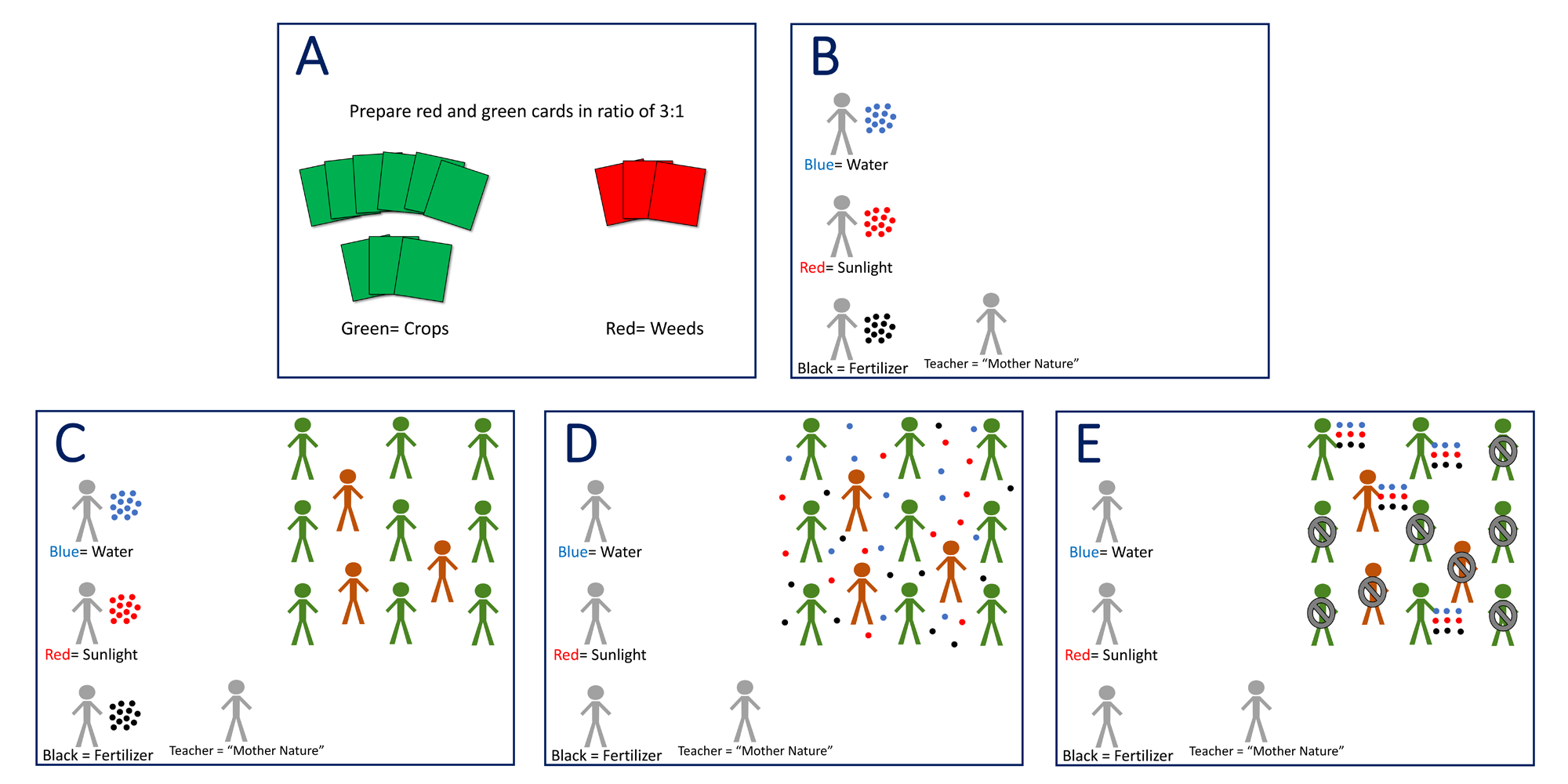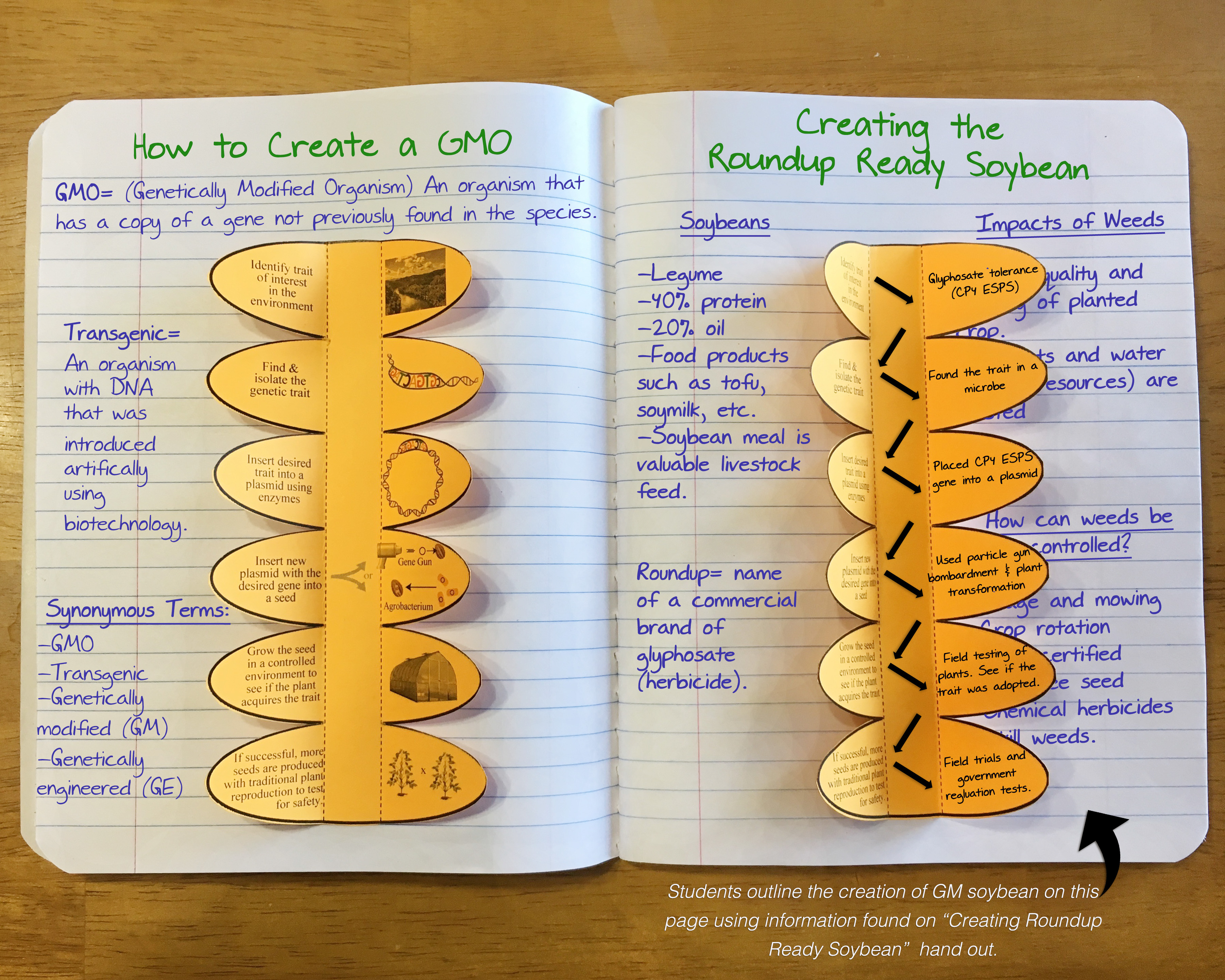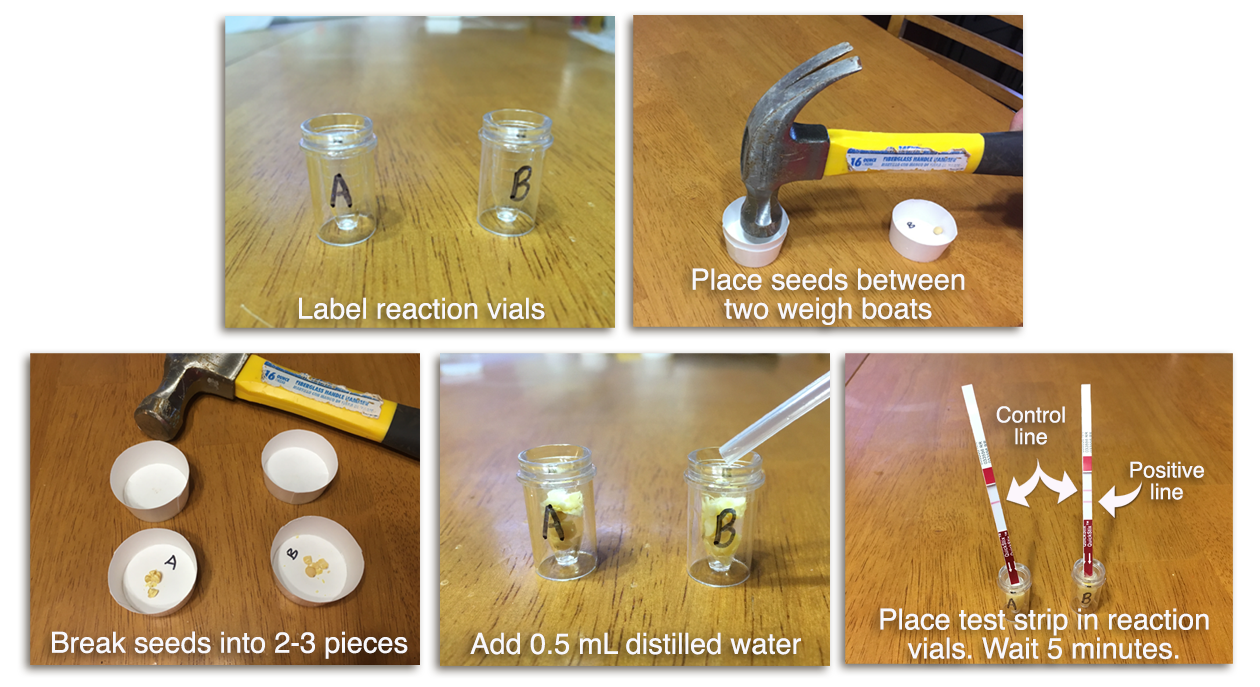There are many ways to modify the genes or genome of plants and other living things. These genetic modification tools vary based on which method is needed for acquiring specific traits. This lesson introduces the scientific process used to create a genetically modified organism (GMO) or a bioengineered plant. While GMOs are a topic of socioscientific debate, this lesson focuses solely on the scientific method and biological processes involved in the development of a transgenic plant.
There are many terms and acronyms used to describe genetically modified organisms or biotechnologies applied in plant science. Genetically engineered (GE), genetically modified (GM), bioengineered, GMO, and transgenic are all adjectives used to describe an organism that has a copy of a gene not previously found in the species.
How GMOs Are Created
Every living organism is made from the instructions encoded in strands of DNA contained in its cells. Changes in this genetic code distinguish one species from another (a cow from a corn plant), as well as one trait from another within a species (a cow with a black coat verses a cow with a red coat). Found within the genome of every species is a series of traits and characteristics. Traits manifested through an organism’s phenotype include colors, sizes, and other observable characteristics. Other characteristics such as drought tolerance, resistance to disease, or resistance to chemicals (such as herbicides) are also found within the genotype of an organism. These genetic characteristics are passed from parent to offspring following the basic rules of inheritance originally discovered by Gregor Mendel.
The steps for creating a bioengineered (GMO) plant include the following:8
- The genetic trait of interest is identified in an organism. The gene must first exist in the genome of another organism such as a plant or bacteria.
- Once the gene responsible for the desired trait is found in a genome, it is isolated.
- The chosen gene is then inserted into a plasmid using enzymes.
- Using the process of transformation, the plasmid containing the new gene is inserted into the genome of the plant using protoplasts, plant embryo, or leaf tissue. There are two methods of introducing new genetic material.
- The particle bombardment method uses a device commonly known as a gene gun. The gene gun shoots metal particles coated with DNA (containing the gene responsible for the trait identified in step one and two above) into the plant tissue.
- Another method uses a bacteria called Agrobacterium tumefaciens. This bacterium naturally invades plant tissue and alters plants by inserting pieces of its own DNA into the plants genome. This natural process can be used to transfer the transgenic gene into the genome of the desired plant.
- Once the gene is inserted into the genome of the plant, it is grown. These early stages of plant growth take place in the controlled environment of a greenhouse. As the plant grows, it is carefully observed. In time, scientists will discover if the desired gene was successfully adopted into the genome of the plant.
- If the newly engineered plant variety contains the desired gene and the adopted trait is successful in its function, the newly engineered seeds are then cross pollinated and the resulting plant offspring are observed for the successful inheritance of the desired trait. The regulatory process will follow to make the seeds commercially available to farmers.
Regulatory Process
After a bioengineered plant is developed, the plant goes through an in-depth series of regulatory tests and trials which are evaluated by the USDA, FDA, and EPA in the United States to determine that the plant and the transgenic gene does not impact the environment in an unintended way or negatively alter the nutritional qualities of the resulting food or animal feed. For example, non-target insects such as pollinators and butterflies are carefully observed to ensure there aren’t any unintended environmental consequences from the newly engineered genome of the plant. Once all regulatory processes are complete, the plant can be approved for commercial use. These regulatory processes are normally carried out by each country that may want to import the seeds to plant or even the foods made from the genetically engineered plant.
The entire process of creating a genetically engineered plant from discovery of the trait to the launch of the seed variety takes several years and can cost over $130 million dollars.17
 |
Due to the complexity and immense cost of creating genetically engineered seed varieties, transgenesis is not the first tool plant breeders employ to obtain desired plant characteristics. |
Weeds and Crop Growth
Weed management is an important factor in agricultural production that impacts crop yield (the amount of a crop that is produced and harvested). Uncontrolled weeds reduce the quantity and quality of a planted crop. Nutrients (found in the soil) and water are necessary, but limited, natural resources for healthy plant growth. Weeds (unwanted plants) compete with planted crops for water and nutrients, thus decreasing the overall harvest and decreasing the efficient use of natural resources.
Farmers can use a variety of weed control methods. There are five general categories of weed control, including preventative, cultural, mechanical, biological, or chemical (with or without biotechnology). Weeds are a constant challenge for every farmer, and herbicides are the primary and most effective tool for farmers to control weeds and maximize crop yields.11 Using herbicides (rather than other weed control methods like hand weeding and tillage) can reduce labor, increase convenience, conserve soil, and make food less expensive to produce.9
The Roundup Ready® soybean was developed in 1990 using biotechnology. In 1996, this biotech crop became commercially available to producers.12 To develop the Roundup Ready® soybean, scientists isolated the 5-enolpyruvylshikimate-3-phosphate synthase (CP4 EPSPS) gene from a naturally occurring microbe (Agrobacterium sp. strain CP4) and used particle gun bombardment plant transformation to insert the gene into the genome of soybean (Glycine max). The gene allows the soybean to produce the CP4 EPSPS enzyme that confers tolerance to the herbicide glyphosate, commercially known as Roundup®. In 2016, over 90 percent of the soybeans grown in the United States were herbicide tolerant.13
The Roundup Ready® soybean was developed to help farmers manage weeds in their fields. When weeds are left to compete with soybeans for the entire growing season, yield losses can exceed 75 percent. Nearly all soybean fields receive some type of herbicide treatment. Monsanto scientists developed the Roundup Ready® soybean technology as a tool to help farmers control weeds in soybean fields.
Comparing Conventional and GM Soybean
In this lesson students will be comparing the conventional and bioengineered soybeans. Students will examine and compare the seeds as well as the growing plants. There is no visual difference between these two varieties of soybean. The seeds and growing plants will, from a phenotypic standpoint, appear fundamentally the same.
The key difference between the Roundup Ready® and the conventional seed is that the Roundup Ready® soybean contains the CP4 EPSPS gene. This gene makes the plant tolerant to glyphosate herbicide. Research conducted by Monsanto and reviewed by global regulatory agencies confirms that the gene results in no other phenotypic changes to the plant.7 The presence of the protein CP4 EPSPS can be verified through a lateral flow immunoassay test. This type of test indicates the presence of a protein and is used for many applications, including in-home diagnostic tests like a home pregnancy test. The biotech industry uses lateral flow immunoassay tests in the process of selecting traits in plant breeding, for quality control and purity testing of seed batches, and to support bioengineered labeling. The technique employs the use of protein specific antibodies that bind to a protein (antigen) that is produced by the GMO plant. This protein is produced as a result of the inserted DNA in the transgenic plant, and it is not present in the conventional plant.

Glyphosate (the primary ingredient in Roundup®) has been used since the 1970s and has been shown to be safe both for the environment as well as in food and feed crops when used according to label directions.15 Due to Roundup Ready® soybean’s tolerance to glyphosate (via the CP4 EPSPS enzyme), Roundup® can be directly applied to soybean fields killing the weeds, but not the soybean. There are many variations of Roundup®. Farmer's use specific formulations of glyphosate to successfully utilize the weed control technology. Formulations of Roundup® available to home owners for lawn and garden use cannot be used successfully due to the addition of other ingredients. Many contain pelargonic acid and diquat dibromide which would kill BOTH the conventional and the Roundup Ready soybean.






